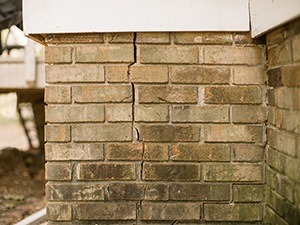
Ever noticed cracks creeping up your house walls or doors not closing as they should? These could be tell-tale signs of an unseen adversary lurking beneath your home. Tree roots, in their relentless pursuit for moisture, can silently wreak havoc on your property’s foundation. Their pressure against your foundation walls could lead to significant structural damage. But don’t panic just yet. There are steps you can take to mitigate these risks and protect your home’s stability. Curious to know how? Let’s unpack this together.
Key Takeaways
- Tree roots, especially from invasive species, aggressively seek moisture and can apply pressure on home foundations, causing cracks and instability.
- Signs of root damage include visible roots near foundations, structural changes like doors not closing properly, and cracks in walls.
- Tree roots can penetrate deep into the soil, but most growth occurs within the top 2 feet, where foundations typically lie, increasing the potential for damage.
- Soil type influences root spread; roots in sandy soils spread wider and may pose a greater threat to foundations than those in clay or compacted soils.
- While all trees can potentially cause damage, aggressive species like willows and poplars tend to have more invasive roots, posing a higher risk to foundations.
Understanding Tree Root Growth
Ninety percent of a tree’s roots reside in the top 12 to 18 inches of soil. This might come as a surprise to you, but it’s an essential fact to comprehend when you’re considering root growth and its potential impact on your property.
Tree species play a significant role in root development. Some trees, like willows and poplars, have aggressive root systems that spread extensively. On the other hand, oaks and pines tend to have deep, less invasive roots. Understanding the nature of your tree’s species can help you anticipate its growth pattern.
Root growth isn’t just about horizontal expansion, though. It’s also about how deep the roots penetrate into the ground. While most roots stay within the top two feet of soil, they can reach deeper in search of water or nutrients, especially in dry or nutrient-poor conditions.
You’re probably wondering, “What does this mean for my property?” Well, knowledge of root growth can help in strategic tree planting. By acknowledging your tree species and its root behavior, you can make smarter decisions and potentially save yourself from future headaches.
Avoid discussing things which would be discussed in the NEXT SUBTOPIC entitled “Root Invasion and Foundation Damage”.
Root Invasion and Foundation Damage
Your home’s foundation may become the ultimate victim of a tree root’s quest for nutrients and water.
Root systems are often misunderstood, seen as passive and benign. But they’re quite the opposite. They’re aggressive, relentless, and they can wreak havoc on your foundation stability.
When a tree is thirsty, its roots will travel far and wide in search of water. They don’t see your home’s foundation as an obstacle but rather as a source of moisture. As roots grow, they apply pressure, gradually causing cracks and weaknesses in the foundation.
Moreover, it’s not just about the physical pressure. Root systems can also leach water from the soil beneath your foundation. This can cause soil to contract and your foundation to shift, leading to severe structural damage.
The worst part? You mightn’t even realize it’s happening until it’s too late.
That’s why you need to be proactive in managing trees and their root systems close to your home.
Identifying Signs of Root Damage
You might be wondering how to identify signs of root damage before it’s too late.
Let’s start by looking at common indicators of root damage.
Then we’ll discuss how to determine the severity of foundation cracks, which can be a major red flag.
Spotting Root Damage Early
Early in a tree’s growth, it’s essential to spot any signs of root damage before it becomes a serious issue. Early detection can save you from costly foundation repairs in the future.
But how do you monitor the roots of your trees effectively?
Effective root monitoring involves regular checks on your tree’s health. You need to become familiar with your tree’s growth pattern. This will help you notice any changes that may indicate root damage.
Are there yellowing leaves or drying branches? It’s not just about what’s happening up top. Check the ground around your tree. Notice any cracks in the soil or bulging roots? These could be signs that your tree roots are expanding and might be threatening your foundation.
You don’t have to be a gardening pro to spot these signs. Remember, it’s all about early detection. The sooner you notice these changes, the sooner you can take action.
Don’t wait until you see cracks in your walls or your doors stop closing properly. By then, the damage might be severe.
Common Root Damage Indicators
Spotting root damage isn’t as challenging as it might seem. Root systems vary greatly depending on the tree species, and their growth patterns can greatly influence the soil moisture levels and foundation types they affect. You’ll notice signs of damage if you’re vigilant.
In urban landscaping, where trees are often in close proximity to buildings, the risks are heightened. Look for visible roots near your foundation. Certain tree species have aggressive root systems that can expand beyond the tree’s canopy, potentially causing damage.
Also, you may notice changes in your home’s structure, such as doors not closing properly or visible cracks in walls, which can indicate a shifting foundation due to root invasion.
Seasonal effects can exacerbate these issues, as root growth can be more vigorous during some seasons, causing additional shifts in soil moisture levels.
If your property has a history of root damage, consider investing in root barriers. These barriers can redirect root growth away from your foundation, preventing potential damage.
Severity of Foundation Cracks
Crack severity, a telltale sign of root damage, can vary greatly. As a homeowner, understanding this range is vital to maintaining your foundation health. Small, hairline cracks mightn’t be cause for alarm, but don’t ignore them. They’re often the first indication that tree roots are interfering with your foundation.
As the roots continue to grow and exert pressure, you’ll notice the cracks getting wider and longer. You may even see horizontal or stair-step cracks, which are more serious. These types of cracks indicate significant movement in your foundation, often a result of root intrusion.
Crack severity can escalate quickly, so it’s important to take action at the first sign of trouble. If left unchecked, these cracks can compromise your foundation health, resulting in costly repairs or even structural failure. Don’t let it get to that point.
Always keep an eye out for changes in your foundation. Remember, early detection and intervention can save you a lot of headaches down the road.
If you’re unsure about the severity of a crack, don’t hesitate to consult a professional for advice. They can assess the situation and guide you in the right direction.
How Soil Composition Affects Roots
Imagine plunging your hands into the soil in your garden. You’re feeling the result of a complex interplay between various soil types, moisture levels, and environmental factors.
The soil type directly impacts root spread. Sandy soils, for instance, allow roots to spread widely due to their loose structure. Conversely, clay soils restrict root spread due to their compact nature. Compaction effects are also noticeable, with heavily compacted soil leading to shallow root growth.
Moisture levels and soil drainage play crucial roles too. Roots need water, but excessive moisture can cause root rot. Well-drained soil helps maintain the right balance.
Nutrient availability is governed by organic matter and pH levels in the soil. High organic matter levels enrich the soil, promoting root growth. However, extreme pH levels can limit nutrient availability, hindering root development.
Seasonal changes bring varying moisture levels, temperature shifts, and alterations in organic matter decomposition, affecting root behavior.
Preventive Measures for Root Damage
Knowing how soil composition affects root behavior, you’re already one step closer to preventing root damage to your foundation.
Now, let’s explore some practical steps for safeguarding your building’s foundation.
First, consider root barriers. These are shields made of durable material like metal or plastic, buried around your foundation. They’re designed to redirect tree roots, keeping them from spreading towards your home base. You can install them yourself, but it’s often best to hire a professional to guarantee they’re placed correctly.
Next, pay attention to tree spacing. Planting trees too close to your house is a surefire way to invite root problems. As a rule of thumb, keep mature trees at least 20 feet away from your home. Remember, roots spread as wide as the tree is tall, so allow ample space for growth.
Repairing Root-Caused Foundation Issues
When tree roots have already wreaked havoc on your foundation, don’t panic – there are effective repair strategies at your disposal.
With some professional help, you’ll be able to restore your home’s stability and prevent further damage.
The first step in foundation repair is to identify the extent of the damage.
You’ll need a professional to thoroughly inspect your foundation and provide a detailed report. This may involve excavating around your home to expose the foundation for a close-up examination.
Here are some viable solutions:
- Foundation Underpinning: Strengthen and stabilize your foundation by extending its depth or breadth. This is usually done with piers or footings.
- Mudjacking: This involves injecting a slurry mixture beneath the foundation to lift it back to its original level.
- Root Barriers: Install these physical barriers to redirect tree roots away from your foundation.
- Foundation Replacement: In severe cases, you may need to entirely replace your foundation.
Choosing the Right Trees Near Home
Choosing the right trees to plant near your home can save you from potential foundation damage.
You need to contemplate the type of tree and its potential root hazards.
Let’s start discussing how to make a wise selection to safeguard your home.
Tree Selection Considerations
You might be surprised to learn that your tree selection plays a significant role in preventing foundation damage. The tree species, their root systems, growth patterns, and the environmental factors inherent to your area, all matter.
Trees with aggressive root systems can disrupt soil moisture balance and cause significant damage if planted too close to your home. Tree maintenance also comes into play. Unmanaged growth can lead to larger root systems, causing potential harm. Root barriers can be helpful, but they’re not a universal solution.
When selecting a tree, consider the following:
- Tree Species: Choose ones with non-invasive root systems. Research is essential.
- Environmental Factors: Consider your region’s climate and soil type.
- Planting Distance: Make sure you plant trees at a safe distance from your home.
- Tree Maintenance: Regular pruning can control growth patterns and minimize potential root invasion.
Potential Root Hazards
Maneuvering through the labyrinth of potential root hazards can be intimidating, but it’s essential for the longevity of your home. Recognizing the key root types is your first step. Shallow, invasive roots can wreak havoc on your foundation, while deep, non-invasive roots are safer options.
Hazard assessments help in identifying which trees pose potential threats. This involves studying a tree’s root system structure and growth patterns. Certain tree species tend to have aggressive root systems that spread far and wide, seeking moisture sources – like your home’s foundation. A simple online search can usually reveal this information about common trees in your area.
You don’t need to completely avoid trees near your home. Instead, choose those with non-invasive roots and plant them a safe distance away.
Size also matters – small to medium-sized trees are generally less threatening to your foundation than larger ones.
Frequently Asked Questions
What Is the Cost of Repairing a Foundation Damaged by Tree Roots?
The cost to repair a foundation damaged by tree roots varies greatly. It depends on the extent of the damage and the repair methods used. You could spend anywhere from $500 to $10,000.
To avoid such costs, it’s best to prevent the damage in the first place. Regularly monitor your trees’ growth and consider root barriers.
Can Tree Roots Damage Underground Plumbing Lines as Well?
Yes, tree roots can indeed damage your underground plumbing lines.
Just as they can disrupt your foundation, roots seek out water sources, often finding them in your plumbing. They’ll intrude into small cracks and, over time, can cause significant plumbing issues.
It’s essential to monitor root systems near your home to prevent such damage. Regular maintenance and checks can help you avoid costly repairs.
Does Homeowners Insurance Cover Foundation Damage Caused by Tree Roots?
You’re probably wondering if your homeowner’s insurance covers foundation damage caused by tree roots.
Unfortunately, most insurance policies don’t cover this. It’s often viewed as a maintenance issue, falling into the domain of damage exclusions.
It’s essential to regularly check for signs of potential problems and address them promptly.
If you’re unsure, review your policy or consult with your insurance agent for a clear understanding of what’s covered.
Is It Safe to Remove a Large Tree Close to My Home on My Own?
While you might be tempted to tackle DIY tree removal, it’s not generally safe to remove a large tree close to your home on your own.
Tree removal safety should be your top priority. Such tasks involve unpredictable factors and require specialized equipment and training.
You’re better off hiring professionals who understand the risks and have the right skills and experience to handle the job safely and efficiently.
What Professionals Should I Consult for a Tree-Root Induced Foundation Problem?
You should consult a certified arborist for a root assessment and a structural engineer for a foundation evaluation.
An arborist can accurately determine the extent of root intrusion and advise on safe tree removal.
A structural engineer would assess the foundation damage and provide repair options.
It’s essential to involve professionals as they’ll guide you through the process, ensuring your home’s safety and structural integrity.
Conclusion
So, you see, unchecked tree root growth can seriously harm your foundation. Watch for signs like visible roots, wall cracks, and misaligned doors. Remember, your soil’s composition also plays a role. Don’t forget to implement preventive measures and fix any issues promptly. Be smart about tree selection near your home. Be proactive in protecting your property – it’s way easier than dealing with costly repairs down the line.

Seal-tite Basement Waterproofing Co. is a full service basement environment contractor. We carry an A+ Better Business Bureau rating. We repaired over 40,000 homes and structures in Virginia, West Virginia, Tennessee, and North Carolina. We are fully insured and licensed. We have worked in all types of locations, including residential and commercial locations, government agencies, colleges, hospitals, churches, and condo associations.
Seal-tite® offers a lifetime transferable warranty. We carry a Class A Contractor’s License and we are fully insured. Our satisfied customers range from government agencies to businesses, hospitals, colleges, churches, and thousands of homeowners. Your home is probably the single largest investment you will make in your lifetime. Don’t wait, call Seal-tite® to help make your home dry, safe and livable.

